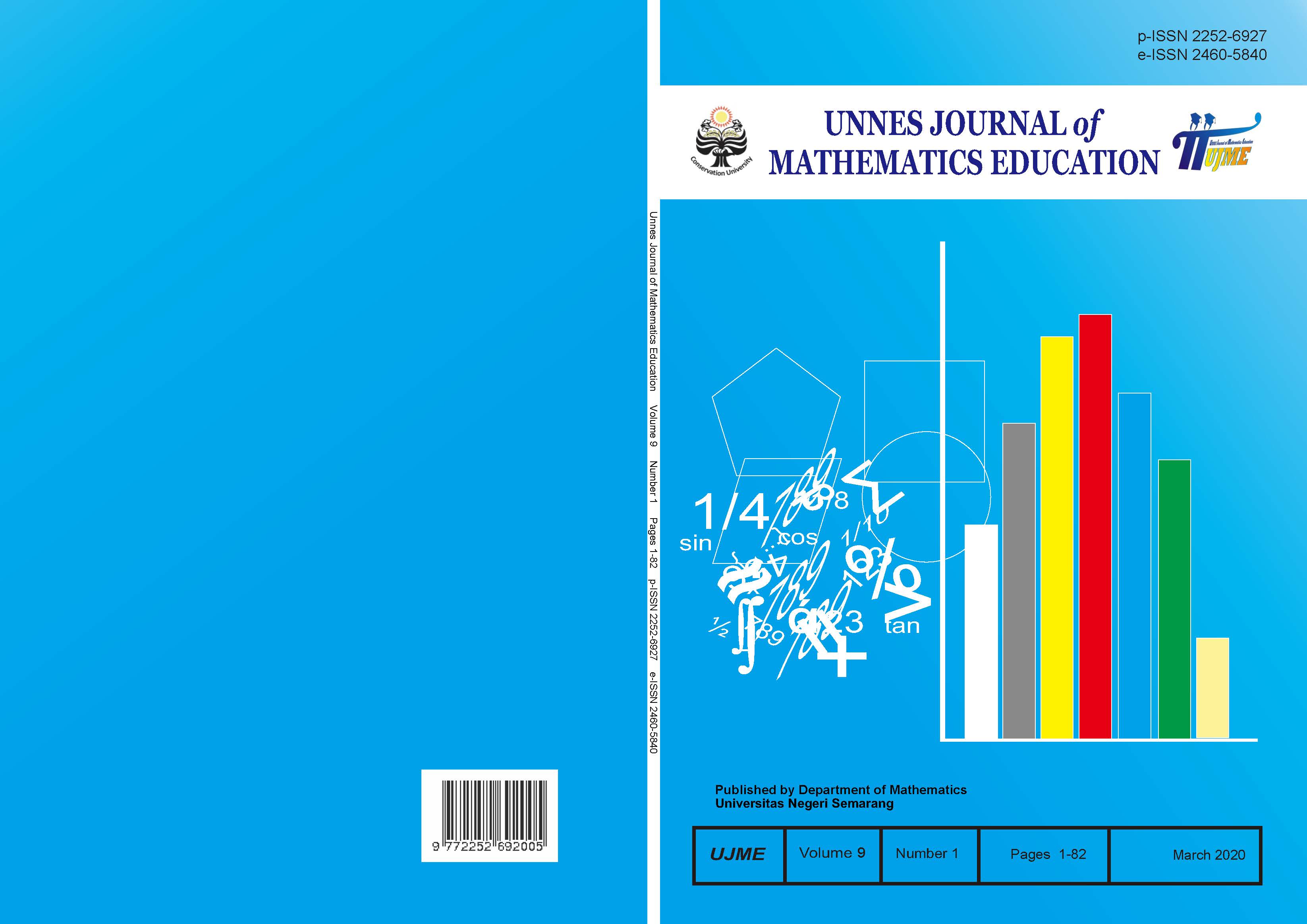The effectiveness of Numbered Heads Together towards the mathematical problem-solving ability
##plugins.themes.academic_pro.article.main##
Abstract
This study aims to determine whether the cooperative learning model type Numbered Heads Together (NHT) is more effective than the conventional learning model towards the mathematical problem-solving ability of VII grade of Salatiga State Junior High School 5 students the academic year 2019/ 2020. This research was Quasi-Experimental type with Non-Equivalent Control Group Design. The instrument of this study was a problem-solving ability test, which consisted of pre-test and post-test. Post-test results obtained an average of 73.24 in the experimental class and 58.62 in the control class. In other words, the average experimental class was higher than the control class. This result was confirmed by the Mann-Whitney U test that obtained a sig (2-tailed) value of 0.00 < 0.05, so H0 was rejected, while H1 was accepted; it meant that there was a difference in the average mathematical problem-solving ability of students between the experimental and the control class. Additionally, the average N-Gain of the experimental class was 0.54, and the control class was 0.29. The average increase in the experimental class was higher than the control class, and there were differences. As the Mann-Whitney U N-Gain test confirmed that obtained sig (2-tailed) value of 0.00 <0.05 so H0 was rejected, and H1 was accepted. Thus there was a difference in the average increase of students' mathematical problem-solving ability between experimental and control classes.
##plugins.themes.academic_pro.article.details##
References
Aziz, H.F. (2017). Efektivitas Pembelajaran Kooperatif Tipe Numbered Head Together dengan Pendekatan Kontekstual Terhadap Pemahamn Konsep Segiempat Kelas VII MTs Matholi’ul Falah (Final Project). Semarang: Universitas Islam Negeri Walisongo Semarang.
Erfian, R. (2011). Komparasi Efektivitas Pembelajaran Kooperatif Tipe Numbered Heads Together (NHT) dengan Pembelajaran Konvensional Terhadap Hasil Belajar pada Mata Pelajaran Akuntansi Siswa Kelas XI IS SMA Negeri 14 Semarang (Final Project) Semarang: Universitas Negeri Semarang.
Hartati, P. (2015). Peningkatan Kemampuan Memecahkan Masalah yang Berkaitan dengan Bangun Ruang Sisi Lengkung Melalui Model Pembalajaran NHT. Didaktikum: Junal Penelitian Tindakan Kelas. 16 (4)
Hidayat, W & Sumarmo, U. (2013). Kemampuan Komunikasi dan Berpikir Logis Matematik serta Kemandirian Belajar: Eksperimen terhadap Siswa SMA Menggunakan Pembelajaran Berbasis Masalah dan Strategi Think-Talk-Write. Delta-Pi: Jurnal Matematika dan Pendidikan Matematika. 2(1).
Huda, M. (2016). Cooperative Learning (Metode, Teknik, Struktur dan Model Terapan). Yogyakarta: Pustaka Pelajar.
Kharisma, F. N., Susilowati, S. M. E., & Ridlo, S. (2018). Problem-Solving Ability in Four Models of Learning. Journal of Innovative Science Education, 7(2), 229-236.
Regulation Minister of Education of Indonesia (Permendiknas) No. 22 2006
Rohman, M. F. (2016). Efektivitas Model Pembelajaran Kooperatif tipe NHT dan tipe TS-TS Berbantuan LKS Berbasis PMRI Terhadap Kemampuan Pemecahan Masalah dan Keaktifan Belajar Siswa SMP. (Final Project). Yogyakarta: Universitas Islam Negeri Kalijaga Yogyakarta.
Ruwanto, B. (2016). Usaha Meningkatkan Prestasi Siswa SMU pada Olimpiade Ilmu Pengetahuan. Jurnal Cakrawala Pendidikan, 2(2). doi:https://doi.org/10.21831/cp.v2i2.9266
Sakti, S. P. (2014). Efektifitas Pembelajaran dengan Pendekatan Pemecahan Masalah (Problem Solving) dalam Setting Pembelajaran Kooperatif Tipe Numbered Heads Together (NHT) Ditinjau dari Peningkatan Pemahaman Konsep dan Komunikasi Matematis Siswa SMP. (Final Project). Yogyakarta: Universitas Negeri Yogyakarta.
Siregar, F. A. (2012). Pengaruh Model Kooperatif Tipe NHT Terhadap Hasil Belajar Siswa Kelas VIII SMP Negeri 18 Medan. Jurnal Pendidikan Fisika 1(1)
Sugiyono. (2017). Metode Penelitian Kuantitatif, Kualitatif, dan R&D. Bandung: CV. ALFABETA.
Sutikno, S. (2014). Metode & Model-Model Pembelajaran (Menjadikan Proses Pembelajaran Lebih Variatif, Aktif, Inovatif, Efektif dan Menyenangkan). Lombok: Holistika.
Wakhyudin, H & Juliyanti, R. (2014). Model Numbereed Heads Together Terhadap Kemampuan Pemecahan Masalah Siswa Kelas IV. Majalah Ilmiah Pendidikan Dasar 4(2) December 2014.
Wardhani, S. (2010). Pembelajaran Kemmapuan Pemecahan Masalah Matematika di SMP. PPPPTK Matematika, Yogyakarta.
Yunarti. (2013). Peningkatan Kualitas Pembelajaran dan Kemampuan Menulis Cerita Pendek dengan Menggunakan Metode Peta Pemikiran (Mind Mapping) pada Siswa Kelas IX A SMP Negeri 9 Pontianak. Jurnal Pendidikan Bahasa dan Sastra 1(1)
